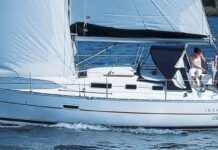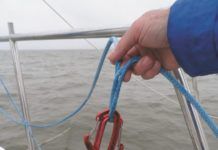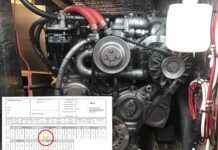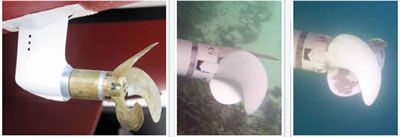Weve experimented with several different prop paints with varying degrees of success, although none of the results so far have been dazzling. Some of our testers have had better success with dedicated slick prop paints such as PropSpeed. In our testing, however, mostly in Chesapeake Bay, no prop paint had lived up to our increasingly faint hope that the paint repel growth as effectively as our hull paint.
For previous articles on this topic check out our report on the dedicated propeller paint PropSpeed (see PS February 2014 online), and a more detailed report on prop paints in general (see PS July 2010 online).
We also looked at Mussel Buster (see PS October 2011 online), a baked-on powder coating that, like PropSpeed, relies on its slick, hard coating (as opposed to biocide) to prevent barnacles from adhering. Other products our testers tried include Feldtens Nano propeller spray treatment, an inexpensive product that appeared no more effective than others.

Lately, we have advised sailors to take one of two options:
Option 1: Blast the prop to bare metal, prime with Interlux Interprotect or a similar barrier-coat epoxy, and then paint with a conventional hard bottom paint. (Although the epoxy theoretically prevents galvanic reaction between dissimilar metals, copper-based paints are to be avoided.) The trick with using a conventional bottom paint (sprays like Interlux Trilux 33 or Pettit Alumaspray are easier to apply) is getting it to adhere, thus the epoxy primer. Although there are options other than epoxy for priming a prop, because of health concerns, these etching primers are not considered do-it-yourself friendly (although they were used that way for years).
Option 2: Use Pettit Barnacle Barrier, a spray zinc product that has given us a years worth of protection in the Chesapeake. Because the prime-and-paint routine hasn’t delivered dividends commensurate with our effort, weve found that applying multiple coats of the relatively inexpensive Pettit Barnacle Barrier is the most practical option. (Readers have also reported unsatisfactory performance with Barnacle Barrier.)
Undeterred, weve carried on with our testing. This time we look at two products that claim to deliver better results than PropSpeed. We were particularly interested in adhesion.
PropGold
Made in Australia by GreenCorp Marine, PropGold is designed for professional application. Although a do-it-yourselfer can manage the application, risks associated with the zinc chromate primer is one of the reasons it is designated for pro application. Like other products weve tested, PropGold relies on a slick, clear outer coating to prevent growth. It appears very similar to PropSpeed. We applied it to one prop on our twin-saildrive catamaran, which is currently cruising in Australia.
Velox Plus
Made in Italy by the Trieste-based company Marlin, Velox Plus has an active biocide, zinc pyrithione, found in many of the aluminum-friendly paints like Trilux 33. Like most coatings, it must be applied over a primer coat. We used the recommended Marlin Metal Primer, both made by the same Italian company. Velox Plus comes in three colors, black, grey, and white but only white was available to us, which is advantageous as any growth will be easily seen. We applied this to one prop and both sail drives aboard our twin-saildrive catamaran.
Conclusion
We are already seeing some slime growth after six months of immersion. The PropGold had two barnacles and was adhering slightly better. The Velox had some slime growth on the saildrive and was already coming off the prop in some places.



































